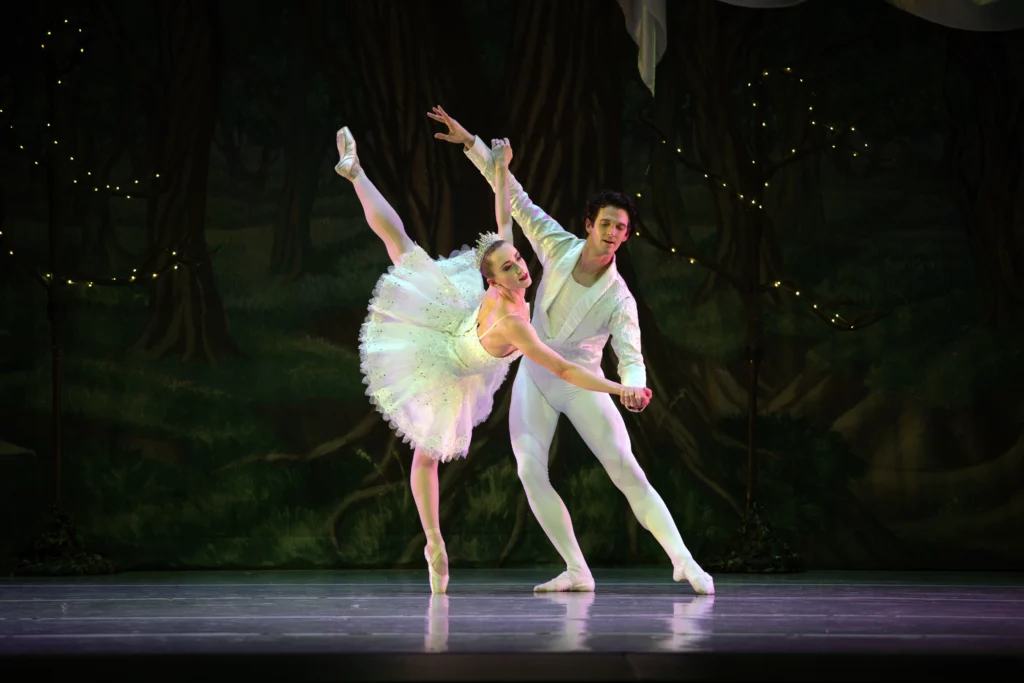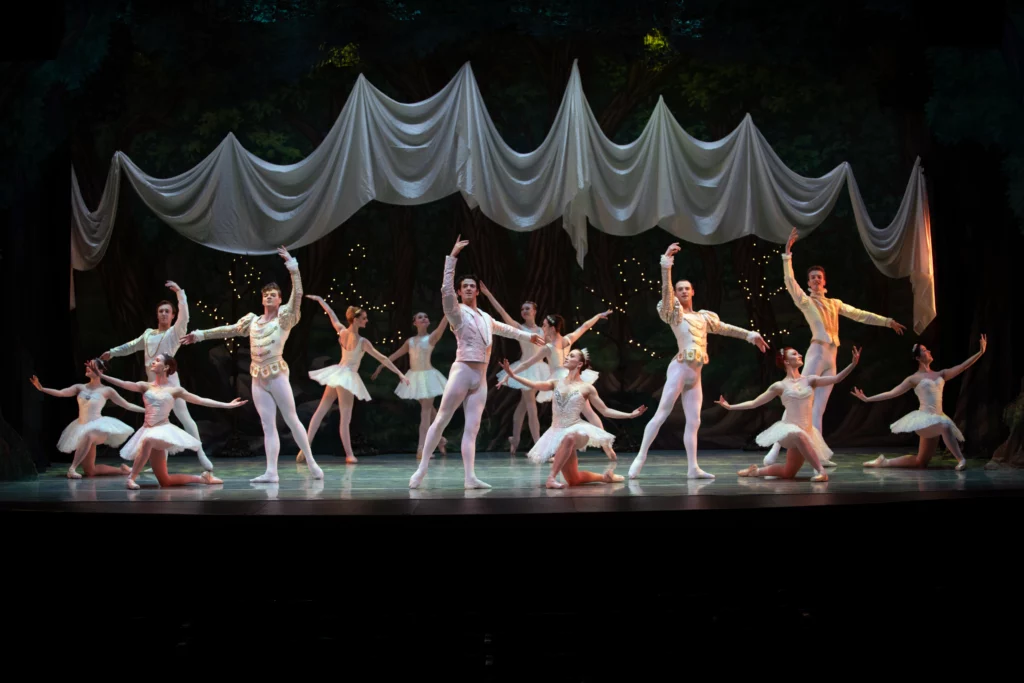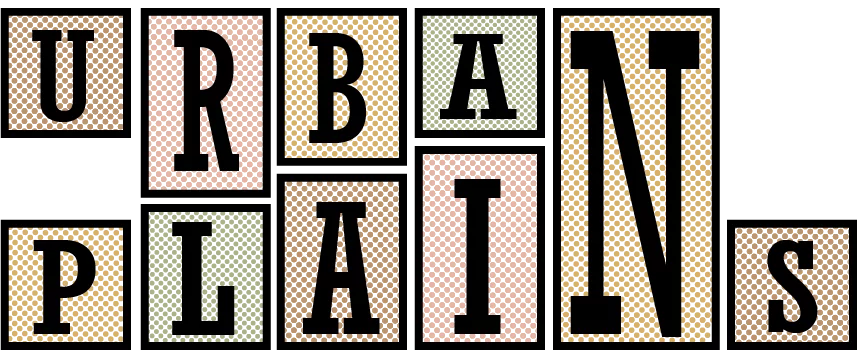Ballet Des Moines’s Logan and Amelia Grubb Hillman strive to make the arts more accessible in the Midwest.

The curtains open, revealing a stage swathed in purple and blue lights. A backdrop of towering trees and lush grass transforms the space into a magical forest. As the music swells, children scamper on and off stage with flashing lights. A whimsiness fills Hoyt Sherman Place as dancers bring to life Shakespeare’s A Midsummer Night’s Dream through movement.
At least until the end of the production. Then the mood changes. There’s a royal wedding. The Duke of Athens and Queen of the Amazons, dancers Logan and Amelia Grubb Hillman, glide onto the stage dressed in all-white attire. Amelia glimmers in her sparkly dress and tiara. Logan guides her body, dipping her back and lifting her up into the air. Once back safely on the ground, Logan bows his head and kisses Amelia’s hand. The chemistry between the two dancers is palpable—and it’s genuine. Because off-stage, Amelia and Logan are a married couple.
“With us, we always say we have an advantage because we already have a relationship,” Amelia says. “We have so much trust with each other already that that just translates automatically on stage.”
Long Distance Love Affair
The two dancers met in 2011 while training at Akhmedova Ballet Academy in Silver Spring, Maryland. In 2013, they both got a job at Columbia Classical Ballet in South Carolina, and during that time they became a couple. After eight months there, the two went back to auditioning, but this time they went through the process together. In 2014, they ended up at Richmond Ballet in Virginia. That came to an end two years later.
“Even if we were the top candidate, which we were, there wasn’t anywhere to go. There wasn’t any space for us,” Logan says.
So they went back on the market. They ended up getting offers from different companies. In 2016, Amelia joined Ballet Des Moines and Logan signed a contract with Nashville Ballet. For the next three years, the couple danced apart. But they also spent that time trying to get into each other’s companies. It finally happened in 2019, with Logan joining Ballet Des Moines. Now reunited, they can do what they love together.
“It’s not just the technical trust, it’s also the emotional trust,” Amelia says. “I feel a lot more confident being on stage with Logan than I do with anyone else, just because I know that he’s always 100% there to support me, with no caveats.”
From Big Cities to Cornfields
The Midwest is its own beast, especially if you’re from someplace else. Hailing from the Washington, D.C. area, Amelia and Logan had to adjust to the Midwestern lifestyle. Amelia was fed stereotypes from friends and family, but says she was pleasantly surprised once she made the move. And Logan was most concerned about the cold weather. Luckily Amelia had the perfect solution: a heavy duty parka.
“My first impressions were just how welcoming and how much people genuinely cared about the people in their community,” Amelia says. “The pride in their own community as well, which was something that I hadn’t really found in other places and that really spoke to me.”
Amelia and Logan have also noticed a difference in the ballet company culture. Not only are they able to find a healthy work-life balance, but they feel supported by the company’s artistic director, Tom Mattingly. When issues arise, they’re able to talk them through with Mattingly and find creative solutions.
“Here it doesn’t feel like you’re constantly fighting for your life or fighting for your approval,” Amelia says. “It feels like you’re respected, and Tom is there to just push you to be the best version of yourself rather than waiting for you to mess up, which is what sometimes it feels like in other companies.”

The Arts Are Not an Afterthought
One notable difference between the Midwest and the East Coast: the amount of access to the arts. Logan felt culturally privileged growing up near D.C. where he could easily see high quality ballet. Without being exposed to good ballet throughout his training, he may not have kept dancing.
“[Seeing performances] and going back to ballet class, I could see, I don’t have to stand at the bar forever. There is an endgame to this,” Logan says.
But the arts are less accessible in the Midwest. In fact, Iowa is ranked No. 48 in the nation for state arts agency spending per capita. These agencies were created by legislatures and governors to promote the arts, but why is Iowa falling behind when it comes to funding the arts?
It could be partly because the Midwest often gets things last, says Jami Milne, arts director of Ballet Des Moines. The East and West Coasts tend to get access to new trends and funding faster. But the deprioritization of the arts could also be due to the fact that they’re treated as almost an afterthought.
“I think oftentimes the arts are thought of as a nice-to-have or sort of like icing on the cake when in fact they are a core part of the human experience,” Milne says.
The arts can help boost an area economically. According to a study conducted by Americans for the Arts, the nonprofit arts and culture industry generated $151.7 billion in economic activity and supported 2.6 million jobs in the U.S in 2022.
Other countries seem to understand the benefits of funding the arts. Many dance companies in Europe get a large amount of their funding from their government. Throughout 2022-2023, the dance industry received £42,591 British pounds from the Arts Council England. Funding is essential to helping a dance company thrive.
“Being able to plan your seasons two to three years in advance is actually common practice in the industry,” Logan says. “But it is not common practice in companies like ours because you don’t know if there’s going to be this amount of money to pay for this specific thing…Anytime you can plan something well in advance it’s going to be more solid, it’s going to be a better product at the end.”
Funding the arts ensures that communities experience its advantages, which includes human connection and health benefits. Even if you don’t consider yourself an artist, art can still take up a vital part of your life. Think about all of the books, movies, TV shows, and music that you consume daily. But witnessing live art can move an audience in a way that’s unique to other media.
“Even a community play will sometimes give you more than watching the very best show on Netflix just because there’s humans there…there’s emotion happening in the same room as you,” Logan says. “It’s very important just as a species to be interacting with that regularly.”
Ballet as a Lens
Ballet isn’t just a beautiful artform, the dance is interdisciplinary. In the past, Ballet Des Moines has engaged with the community by educating students on subjects ranging from science to law. In 2022, Ballet Des Moines translated the science of the solar system into music and dance with their production Of Gravity and Light.
The production had an accompanying seventh grade science curriculum of four learning modules, which is free to use. The curriculum is published through Iowa State University and distributed by 4-H Youth Development, Iowa PBS/PBS Learning Media, and Ballet Des Moines. During the time of the production, classrooms were able to watch the school show, then go back and study the modules and compare it to the ballet production. Now a video of the production is available at Iowa PBS’s website.
“When you think about some of these really hefty science concepts they make much more sense when your body is turning or twisting or almost engaging with the tides of the moon,” Milne says. “I think the arts allow people to get things by almost allowing or forcing your brain to look at it a little bit differently.”
Ballet Des Moines will continue to add an arts twist to other educational subjects with their 2024 Summer STEM Tour that takes place in June across Iowa. With stops in Dubuque, Waterloo, Cedar Rapids, and Des Moines, the dancers will perform excerpts from A Midsummer Night’s Dream and Mattingly’s Love Letters, which is an ode to the queer community of Iowa. Interactive STEM and arts activities will take place after the performances.
Amelia and Logan will be among the dancers taking part in the tour. While they feel fulfilled bringing ballet to places all over Iowa, there are still towns they wish they could go to that don’t currently have the funding to pay for it.
“A lot of places we go are college towns, or places with some sort of strong financial support in the area,” Logan says. “But there are lots of places that don’t have that. We’d like to go there, but we can’t. That’s something that the state could be helping with.”
But the upcoming tour isn’t the company’s only exciting upcoming event. Ballet Des Moines is getting a studio upgrade. Previously tucked away near Valley Junction, the company is moving downtown at 655 Walnut St. The large studio is finished, and members have been dancing there since the beginning of the year. The rest of the new space is nearing completion. Not only does the new studio have more room, but the location helps bring awareness to the importance of the arts in Iowa.
“For a long time we talked about how beautiful it would be to be in the heartbeat of downtown and that community and allow people to be walking past and look in a window and see the accessibility [of the ballet,]” Milne says.
While Iowa may be vastly different from the coasts, the arts are still just as valuable. They are an outlet to broadcast all kinds of stories and experiences. And the Midwest should not be neglected.
